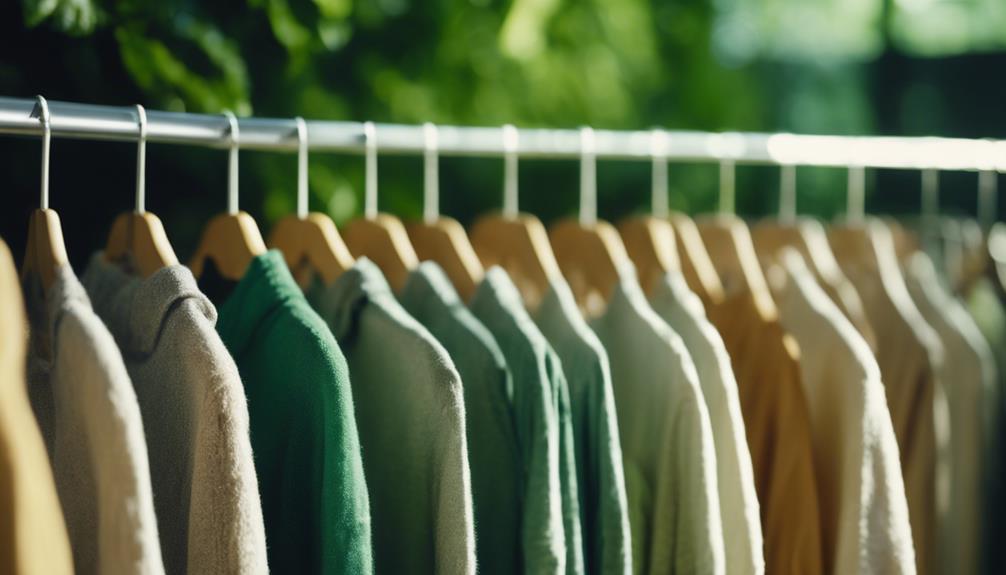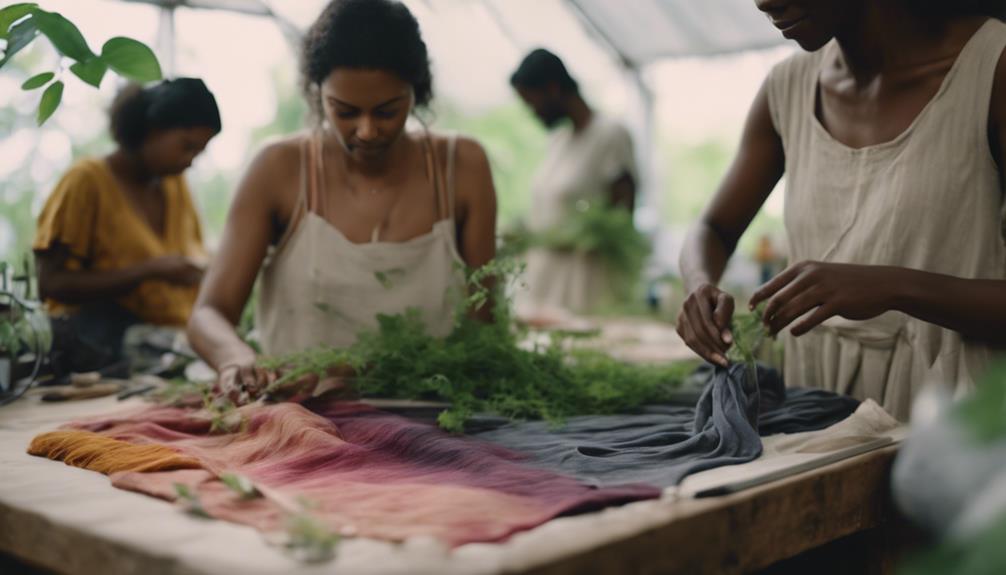In order to support sustainable fashion, it is important to prioritize quality over quantity. Look for ethical brands that prioritize transparency and sustainable materials, such as organic cotton or linen. Embrace second-hand shopping to prolong the life of clothing and reduce waste, and remember that proper care can increase the longevity of your garments. Consider upcycling old clothes into unique pieces to minimize your environmental impact. Adopting a minimalist mindset will help you curate a wardrobe that aligns with your values and simplifies your choices. There is much to explore when it comes to making conscious fashion decisions that can truly transform your style and impact!
Key Takeaways
- Seek brands with sustainability certifications like Fair Trade Certified or GOTS for assurance of ethical practices.
- Prioritize high-quality clothing made from sustainable materials, ensuring durability and reducing waste.
- Embrace second-hand shopping to extend clothing lifecycles and minimize the demand for new production.
- Research brand transparency regarding supply chains and production processes to make informed purchasing decisions.
Educate Yourself on Sustainability
To truly embrace sustainable fashion, you need to educate yourself about eco-friendly brands and their practices. Start by researching sustainable brands that prioritize ethical production methods and transparency. Understanding their practices can empower you to make informed choices. Familiarize yourself with sustainability certifications like Fair Trade Certified and GOTS, as these labels indicate adherence to ethical standards in labor and material sourcing.
It's essential to recognize the environmental impact of the fashion industry, which contributes to 8% of global greenhouse gas emissions. This knowledge can deepen your appreciation for sustainable fashion and motivate you to support brands that prioritize eco-conscious designs.
Use social media to engage directly with these brands, asking questions that clarify their sustainability practices. Additionally, keep track of your purchasing habits. Studies show the average person wears only a fraction of their wardrobe, highlighting the importance of buying less.
Invest in Quality Clothing
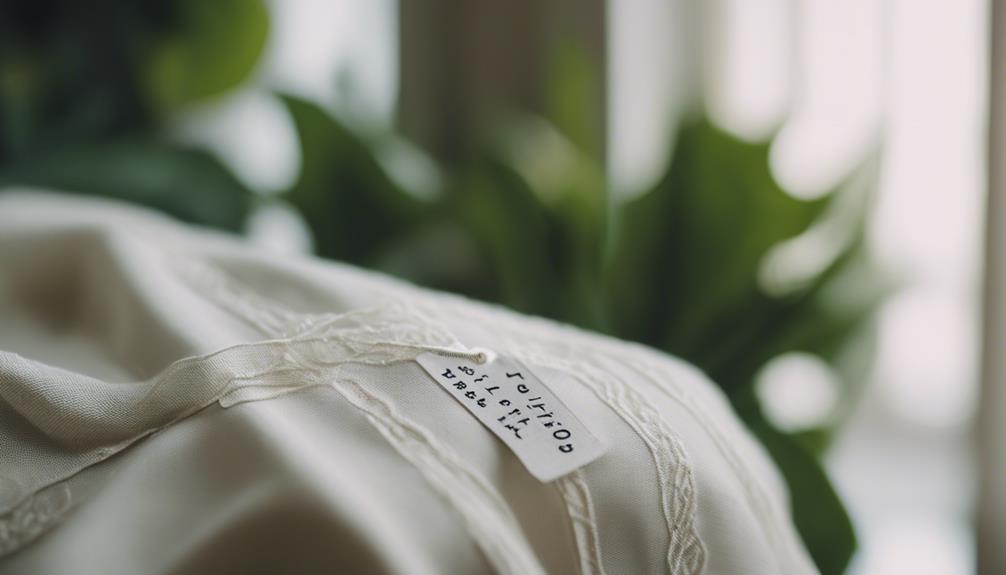
Investing in quality clothing not only enhances your wardrobe but also reduces waste and supports a more sustainable fashion industry. When you choose to invest in quality clothing, you're opting for durability over the fleeting trends of fast fashion. High-quality garments last longer, which means you won't need to replace them as often, helping to minimize overall consumption and waste.
Brands like Patagonia exemplify this approach, combining craftsmanship with ethical practices. They offer repair services, encouraging you to think twice before discarding your pieces. By prioritizing timeless pieces, such as classic jeans or tailored shirts, you can create a versatile wardrobe that remains stylish across seasons.
Additionally, opting for sustainable materials like organic cotton or hemp further boosts the longevity and environmental friendliness of your clothing. These materials are often more durable and less harmful to the planet, allowing you to make better choices for both your wardrobe and the environment.
Embrace Second-Hand Shopping

When you embrace second-hand shopping, you not only discover unique vintage finds but also help reduce the environmental impact of fast fashion.
Each pre-loved item you choose extends its lifecycle, supporting a more sustainable approach to clothing.
Plus, thrift shopping can save you a significant amount of money while allowing you to express your individuality.
Unique Vintage Finds
Embracing second-hand shopping not only uncovers unique vintage finds but also champions sustainable fashion by reducing waste and promoting individuality. When you engage in thrift shopping, you're likely to discover unique styles that can't be found in mainstream stores. These second-hand garments allow you to express your personal taste while supporting sustainable practices.
By choosing pre-loved items, you actively participate in the circular fashion movement, which focuses on recycling and repurposing textiles. This greatly helps extend the lifecycle of clothing, ensuring fewer items end up in landfills. In fact, research shows that around 60% of clothing is discarded within a year, making your choice to shop second-hand even more impactful in combating fashion waste.
Additionally, thrift shopping is a budget-friendly way to build your wardrobe without compromising quality. You'll often find high-quality items at a fraction of the price, which makes it easier to adopt an eco-conscious lifestyle.
Environmental Impact Reduction
Second-hand shopping greatly cuts down on the environmental impact of the fashion industry by reducing the demand for new clothing production. When you choose thrift shopping, you're actively participating in a movement that helps mitigate climate change. Did you know that new garment production accounts for around 8% of global greenhouse gas emissions?
By opting for second-hand clothes, you extend their lifecycle and keep them out of landfills, where an estimated 60% of clothing ends up within a year.
Moreover, thrift shopping saves up to 75% of the resources typically used in creating new clothes, including water, energy, and raw materials. Each second-hand piece you buy can save approximately 3,000 liters of water—especially critical given the water-intensive nature of cotton farming.
Not only does this practice reduce environmental impact, but it also allows you to discover unique styles that set your wardrobe apart from mainstream fashion trends.
Prioritize Clothing Care
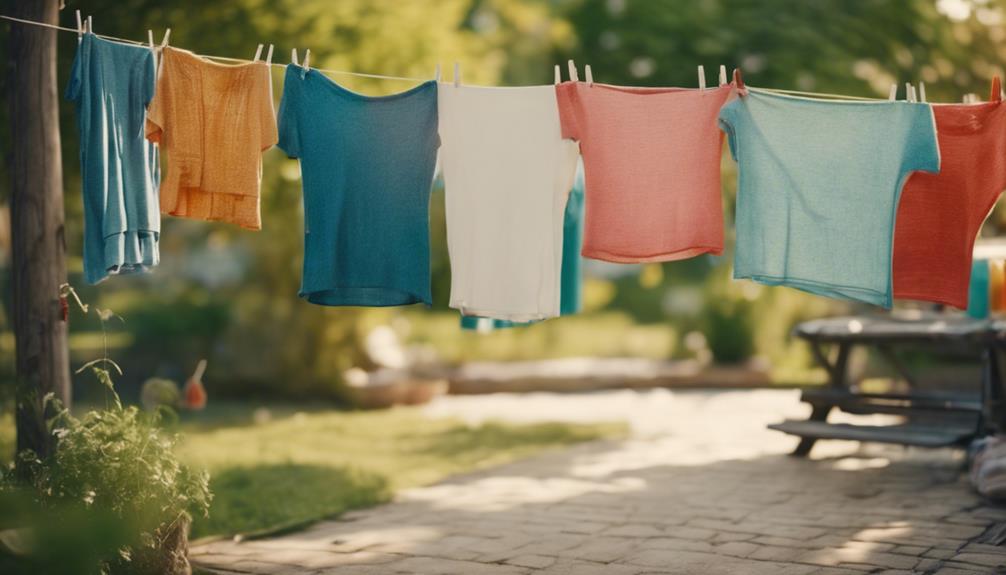
Prioritizing clothing care is essential for extending the lifespan of your garments and reducing waste. When you invest time in proper clothing care, you not only help reduce the demand for new items but also make sustainable fashion a reality. Washing your clothes less often can greatly extend the life of fabrics, allowing you to enjoy your wardrobe for years to come.
Choose eco-friendly detergents that maintain garment quality while lessening the environmental impact of your laundry routine. Regular maintenance, like using steamers or fabric shavers, keeps your clothes looking fresh and reduces the need for replacements. By learning basic clothing repair techniques, you can easily fix small issues, promoting a more sustainable approach to fashion consumption.
Many ethical and sustainable fashion brands encourage these practices, emphasizing the importance of caring for what you own. By prioritizing clothing care, you contribute to a more sustainable future, supporting a cycle that values quality over quantity.
Explore Upcycling Opportunities

Finding innovative ways to repurpose old clothing can breathe new life into your wardrobe while considerably reducing textile waste. Upcycling allows you to creatively transform garments into unique items like bags or pillow covers, directly impacting the environment by minimizing waste. Engaging in upcycling extends the life of your clothing, with studies showing that just nine extra months of use can reduce environmental impact by 30%.
To get started, explore online tutorials or local workshops that inspire DIY upcycling projects. These resources can refresh your wardrobe sustainably and help you develop valuable skills. Your upcycled creations won't just be eco-friendly; they'll also reflect your personal style, making them one-of-a-kind pieces that stand out.
Additionally, consider collaborating with local artisans for upcycling projects. This approach not only supports community sustainability efforts but also fosters a positive impact through shared resources and skills. By embracing upcycling, you can enjoy fashion that's both stylish and environmentally responsible, proving that you can express your personal style while making a difference.
Support Ethical Fashion Brands
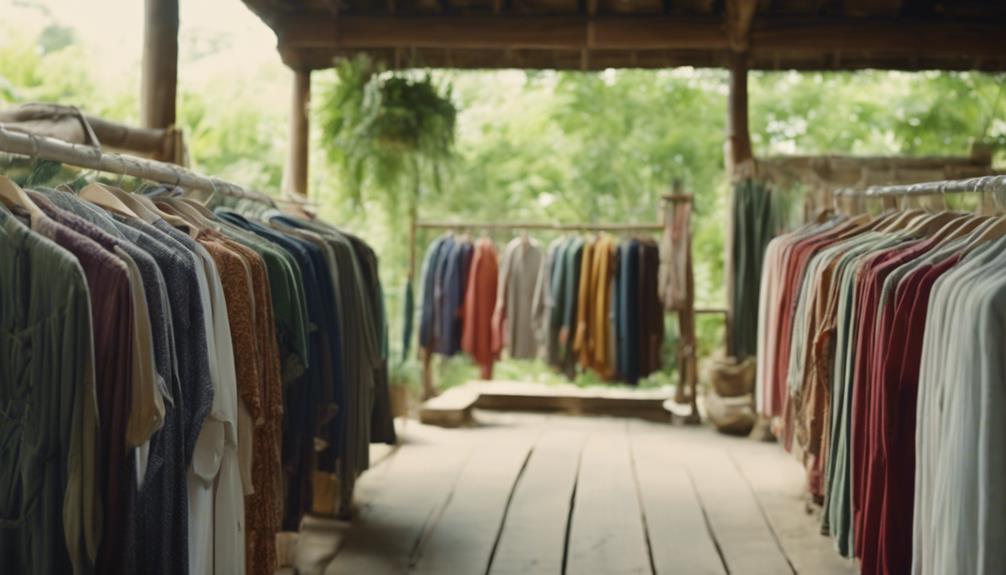
Supporting ethical fashion brands empowers you to make a positive impact on the industry while expressing your unique style. Every time you choose to shop consciously, you support values that matter.
Here are some tips to help you make informed choices:
- Research Brands: Look for labels like Everlane and Pact that prioritize transparency and ethical practices.
- Check Certifications: Seek out brands with Fair Trade Certified or GOTS labels, ensuring they follow strict ethical and environmental guidelines.
- Inquire About Practices: Don't hesitate to ask brands about their supply chain and production processes. This knowledge helps you make informed choices.
- Choose Natural Fibers: Opt for clothing made from sustainable materials, like organic cotton or linen, which are kinder to the environment.
Adopt a Minimalist Mindset
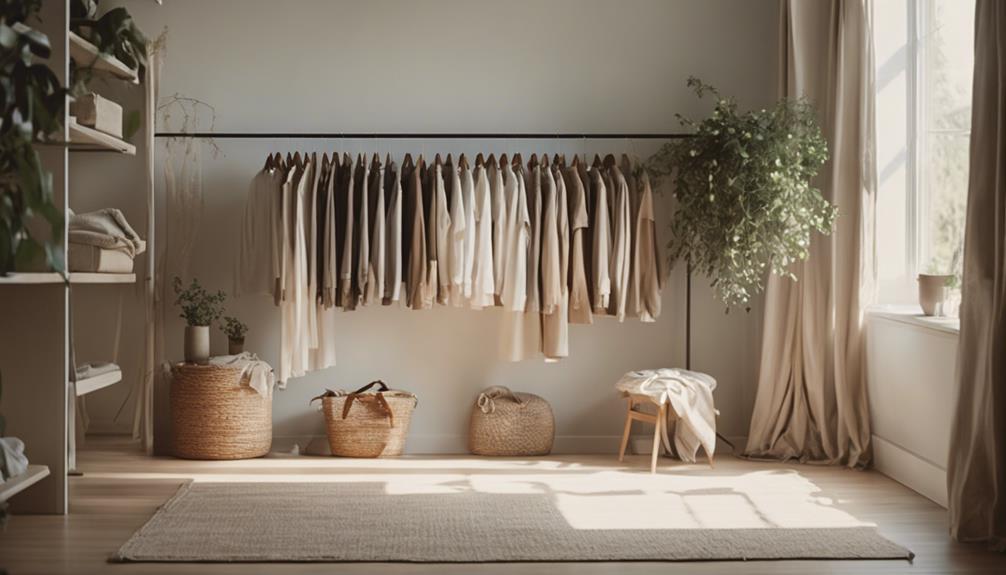
Embracing a minimalist mindset can transform your wardrobe and reduce your clothing consumption considerably. When you focus on owning fewer, high-quality pieces, you'll find that you actually wear much less than you think. Studies show the average person only wears about 20% of their wardrobe regularly. By considering using versatile garments, like classic jeans and tailored shirts, you can create outfits for various occasions without needing to buy new clothes frequently.
A minimalist approach doesn't just simplify your wardrobe; it helps enhance your personal style. By investing in timeless pieces, you'll make better fashion choices, leading to less impulse buying. Plus, adopting a one-in, one-out policy can keep your wardrobe manageable. For every new item you acquire, donate or repurpose an old one, fostering a circular fashion mindset.
Ultimately, a minimalist mindset encourages thoughtful consumption. You'll find that your day-to-day dressing becomes easier, as you'll have a curated selection of clothes you're truly excited to wear. This shift not only benefits you but also contributes to a more sustainable fashion landscape. So, start decluttering and embrace a wardrobe that reflects your values.
Frequently Asked Questions
What Are the Factors Affecting Sustainable Fashion?
Sustainable fashion hinges on several factors, like material choices, production methods, and consumer habits. You can impact this by opting for eco-friendly brands, avoiding fast fashion, and supporting initiatives that prioritize ethical practices and waste reduction.
What Are the 6 R's in Making Fashion Sustainable?
To make fashion sustainable, you should Reduce consumption, Reuse clothing creatively, Recycle materials responsibly, Repair damaged items, and Refuse fast fashion. Embracing these 6 R's empowers you to contribute positively to the environment and fashion industry.
What Are the Risks of Sustainable Fashion?
Sustainable fashion carries risks, like greenwashing that misleads you, higher prices that limit access, and confusion over material lifecycles. Awareness of these challenges helps you make informed choices and reduces unintentional harm to the environment.
How to Contribute to Sustainable Fashion?
Sustainable style starts with smart shopping! Seek brands that shine in sustainability, savor second-hand treasures, support circularity through donations, and select superb, timeless pieces that last. Your choices can change the fashion game for good! To make your sustainable style journey even easier, consider these sustainable fashion tips. Look for clothing made from organic or recycled materials, and prioritize quality over quantity. Embrace a more minimalist approach to your wardrobe, and invest in versatile pieces that can be mixed and matched for different looks. With these sustainable fashion tips in mind, you can be a conscious consumer and make a positive impact on the fashion industry.
Conclusion
By embracing sustainable fashion, you're not just making a style choice; you're contributing to a larger movement that challenges fast fashion's harmful impact.
While some believe that sustainability comes at a higher cost, investing in quality and second-hand pieces often saves you money in the long run.
So, next time you shop, remember: supporting ethical brands and caring for your clothes can help create a more sustainable future without sacrificing your personal style.
